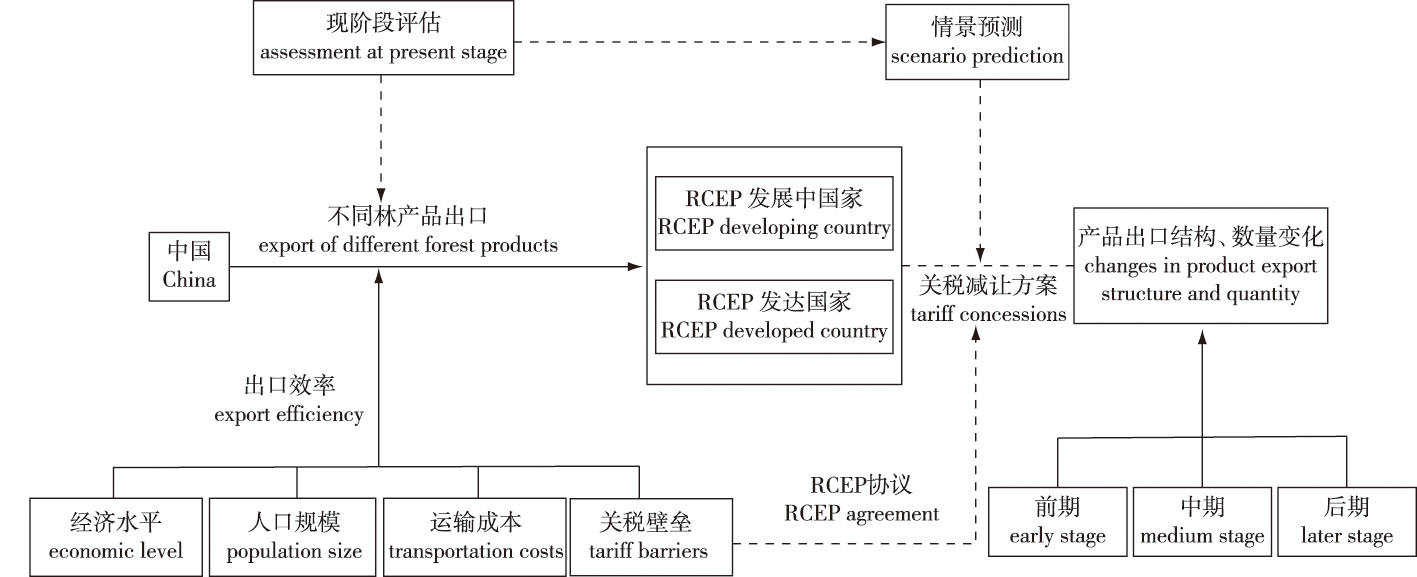 PDF(1878 KB)
PDF(1878 KB)


The export efficiency and potential capacity of China’s forest products to RCEP member countries
PAN Lei, XIONG Lichun, YAO Yuchen, LIANG Zhao, ZHU Zhen
Journal of Nanjing Forestry University (Natural Sciences Edition) ›› 2024, Vol. 48 ›› Issue (1) : 237-247.
 PDF(1878 KB)
PDF(1878 KB)
 PDF(1878 KB)
PDF(1878 KB)
The export efficiency and potential capacity of China’s forest products to RCEP member countries
【Objective】 To discuss China’s export efficiency and potential capacity of forest products to Regional Comprehensive Econoroic Partnership(RCEP) member countries, it is important to identify the future expansion of China’s forest product exports to other RCEP member countries and to optimize the export market and structure of China’s forest products. 【Method】 Based on China’s forest product export data to RCEP member countries from 2004 to 2018, the stochastic frontier gravity model was used to analyze China’s forest product export efficiency to RCEP member countries and forecast the potential export capacity combined with tariff reduction scenarios. 【Result】 Trade barriers, transportation and economic policies have negative impacts on the export efficiency of forest products in China. With the establishment of RCEP, RCEP countries will further occupy the export market of China’s forest products, which will help expand China’s export of forest products to developing countries. 【Conclusion】RCEP will further adjust and optimize the export structure of forest products in China. Differentiated policies should be designed for forest products to accelerate the reduction of trade barriers among RCEP countries, advance negotiations with RCEP countries on forest product tariff reduction, and enhance the competitiveness and added value of paper products by improving innovation capabilities.

Regional Comprehensive Economic Partnership(RCEP) / export efficiency / potential capacity of exportation / exportation structure / tariff concession / forest products trade
| [1] |
蔡鸿毅, 王静怡, 刘合光. 区域全面经济伙伴关系的经济影响分析[J]. 世界农业, 2017(7):11-17,38.
|
| [2] |
齐玮, 彭晓亚, 熊含瑜. “一带一路”沿线国家贸易便利化水平对进出口贸易的影响[J]. 统计与决策, 2021, 37(8):144-147.
|
| [3] |
杨桔, 祁春节. “丝绸之路经济带”沿线国家对中国农产品出口贸易潜力研究:基于TPI与扩展的随机前沿引力模型的分析框架[J]. 国际贸易问题, 2020(6):127-142.
|
| [4] |
曹安, 汪晶晶, 黄如梦. 中国与“一带一路”沿线国家农产品出口贸易效率及潜力测算[J]. 统计与决策, 2018, 34(10):113-117.
|
| [5] |
吴天博, 田刚. “丝绸之路经济带”视域下中国与沿线国家木质林产品贸易:基于引力模型的实证研究[J]. 国际贸易问题, 2019(11):77-87.
|
| [6] |
赵雨霖, 林光华. 中国与东盟10国双边农产品贸易流量与贸易潜力的分析:基于贸易引力模型的研究[J]. 国际贸易问题, 2008(12):69-77.
|
| [7] |
庄丽娟, 姜元武, 刘娜. 广东省与东盟农产品贸易流量与贸易潜力分析:基于引力模型的研究[J]. 国际贸易问题, 2007(6):81-86.
|
| [8] |
李文霞, 杨逢珉. 我国农产品出口贸易潜力研究[J]. 统计与决策, 2017(3):134-137.
|
| [9] |
李月娥, 张吉国. 中国农产品贸易效率及潜力研究[J]. 统计与决策, 2021, 37(11):112-116.
|
| [10] |
王芳, 田明华, 程宝栋, 等. 后危机时代中国木质家具出口影响因素及贸易潜力研究:异质性随机前沿出口模型实证分析[J]. 林业经济问题, 2019, 39(4):337-346.
|
| [11] |
|
| [12] |
|
| [13] |
刘艺卓, 赵一夫. “区域全面经济伙伴关系协定”(RCEP)对中国农业的影响[J]. 农业技术经济, 2017(6):118-124.
|
| [14] |
蔡玉秋, 刘辰洋. 中国对RCEP成员国林产品出口效率及潜力研究:基于亚太经济一体化视域[J]. 价格月刊, 2020(8):39-46.
|
| [15] |
李文霞, 杨逢珉. 中国农产品出口丝绸之路经济带沿线国家的影响因素及贸易效率:基于随机前沿引力模型的分析[J]. 国际贸易问题, 2019(7):100-112.
|
| [16] |
|
| [17] |
|
| [18] |
贾伟, 屈四喜. 中国各省份—东盟农产品贸易增长的实证分析[J]. 中国农村经济, 2012(3):25-34.
|
| [19] |
张萌, 张宗毅. 我国农机产品出口贸易流量及潜力:基于引力模型的实证分析[J]. 国际贸易问题, 2015(6):148-154.
|
| [20] |
|
| [21] |
|
| [22] |
|
| [23] |
周曙东, 郑建. 中国与RCEP伙伴国的贸易效率与影响因素:基于随机前沿引力模型的实证分析[J]. 经济问题探索, 2018(7):89-97.
|
| [24] |
秦炳涛, 王唯一, 刘蕾, 等. 中国—RCEP国家贸易研究:基于随机前沿引力模型的贸易效率与潜力[J]. 广西财经学院学报, 2020, 33(6):1-17.
|
| [25] |
何宜庆, 万媛媛, 何典芝. 次贷危机下我国资本市场与银行体系跨市场风险传染实证研究[J]. 南昌大学学报(理科版), 2009, 33(6):551-556.
|
| [26] |
敖丽红, 赵儒煜. 关于中日韩自贸区建设的理论与实证分析[J]. 东北亚论坛, 2013, 22(4):73-81,129.
|
| [27] |
谢京辞, 李慧颖. 轴辐式海陆物流一体化网络构建研究:以山东省为例[J]. 经济问题探索, 2015(3):1-8.
|
| [28] |
王玉燕, 林汉川. 全球价值链嵌入能提升工业转型升级效果吗:基于中国工业面板数据的实证检验[J]. 国际贸易问题, 2015(11):51-61.
|
| [29] |
陈俊峰, 戴永务, 洪燕真. 世界主要林产品贸易国林产品比较优势动态演变[J]. 林业经济问题, 2020, 40(2):199-207.
|
| [30] |
张丽媛, 曹旭平. 中国木质林产品出口波动特征及成因分析[J]. 林业经济问题, 2018, 38(6):15-20,100.
|
| [31] |
徐若霖. TPP对中国林产品贸易影响探究[D]. 北京: 北京林业大学, 2017.
|
| [32] |
郭连成, 左云. 中国与欧亚经济联盟国家的贸易效率及潜力研究:基于随机前沿引力模型的分析[J]. 经济问题探索, 2021(3):100-110.
|
| [33] |
梁一新. 中美贸易摩擦背景下加入RCEP对中国经济及相关产业影响分析[J]. 国际贸易, 2020(8):38-47.
|
| [34] |
庞新生, 宋维明, 刘蕊. 中国纸和纸制品国际竞争力评价分析[J]. 价格理论与实践, 2016(3):152-155.
|
/
| 〈 |
|
〉 |